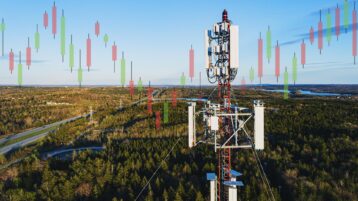Equity markets continue to fall as recession rumbles grow louder. Kim Parlee asks Phil Davis, founder of philstockworld.com, if there is more pain to come, or could we be finding a bottom.
[MUSIC PLAYING]
- Well, the first quarter and then some of 2022 is in the books and what a year it has been. What a day it has been. We've got the S&P 500 looking to be trading at a year low as of the market's today. If you take a look at the markets, it was not a pretty day. And it has not been a pretty year so far and investors are certainly feeling the pain. The question is how much more pain is there to come? Is there more pain to come? Are we anywhere close to a bottom or maybe are we even there?
Joining me now to give us his take on this is Phil Davis, founder of Phil Stock WorldCom. And he joins me from Fort Lauderdale. We always love talking to Phil. Such great insights. Phil, I'll just start with. Hi, how are you to start with.
- Thanks. I'm very good, Kim. How are you doing?
- I'm doing not bad. I'm doing not bad. Not tough day, though, I'd say, right across the board the market. So here's the question everybody wants to know, in your opinion, are we there yet? Are we close to a bottom is the worst over or is there more to come?
- Well, I think the thing to make clear is that this what we're having now is a correction so there's no bottom here this is a correction moving the market to a correct price or the indexes to a correct price. We had a fairly large overshoot probably about 20% overshoot in the market of what realistic values are.
And we think probably 4,000 is even possibly low, but 4,000 and maybe 3,600, should be the worst on the S&P, so 10% below here. There's enough bargains, there's enough value where people like us who are value investors are going to step in and really put some cash to work. I mean, right even now though, we're starting to nibble because we see some fun stuff. In fact, Cisco just fun. this evening.
- Let me-- we'll talk about the nibbling in a second in terms of what you like, but can you just tell me a bit about what you're talking about? When you say, 4,000 or 3,600. What is that? I know we've talked about midpoints before. Is that a midpoint? Because things can overshoot the midpoint before they sell?
- Yeah, absolutely. That's the thing I think 4,000 is probably going to be the proper range for the S&P, assuming nothing else happens. But as I said the other day in our newsletter, I said what else could happen? Everything is already happening. It's like a disaster movie out there. So I think a lot of this stuff is kind of priced in now, and hopefully we can get back to business and sort ourselves out and start looking more at the company. It's certainly a stock pickers market though going forward.
- It will be assuming those stock pickers have the funds to pick with, and they were smart about the downturn getting there. One of the big reasons we've seen the sell off, I'd say initially, concerns about inflation. And we've had of course central bankers saying they have no problem raising more as they move forward. But you're saying inflation can be your friend as an investor. Why do you say that?
- Oh well, I mean if you look at, for example, take Yum Brands, for example. Yum Brands does-- they sell $6 billion, $6.5 billion, worth of tacos and chicken around the world. And they make a 20% profit, which is $1.3 billion selling it. Now if you have 10% inflation what that does is it gives them $7.8 billion in revenues. And if they maintain their profit line their profit goes up to 1.56 from 1.3. On 10% inflation, that's a 20% boost to their profits.
And the market doesn't care about the real buying power of these changes. The market cares about the raw numbers to a large extent. Not only that, though but then people who want to buy their stock have to buy this stock with weaker dollars. And that means that the stock becomes more expensive relative to the cash that you have because your cash ain't nothing but trash is the common expression.
So inflation, if you're a holder of equities, eventually, maybe not at first. Like Target right now, great example. Target, Walmart, they get hit by a cost increase first, then they pass it along to their customers. But first they have this period, which we're in right now of where the cost increase hits them. Labor costs, raw material costs, costs from the manufacturers that have to get passed on to them, shipping costs. All this stuff hits them first. Then they have to reprice and pass it along. But we've gone through this so many times it's amazing how people panic. This is just how the cycles work. In early inflation cycle, you're going to see this kind of thing where the retailers haven't had a chance to past prices out to the consumers yet.
- What about-- so, inflation if you can figure out to be in the right side of inflation is a very positive thing. What about the inflation of debt? And I'm mixing metaphors here, but the cost of servicing debt is going to start mattering to people, to companies. So what impact is that going to have.
- That's the biggest negative we have going forward is that isn't really priced into the market yet, and again, into certain companies because some companies have that, some companies don't. But as a rule of thumb if your company paid $200 million worth of interest last year, than you can pretty much count on it over the next two years they'll be paying $400 million worth of interest.
You've got to be very careful with how much debt your company is carrying on the books because the cost of servicing debt will double. It's a fact. Everybody's cost of debt will double and the companies that they rely on constantly rolling their debt over and need to sell more every year, those companies are going to get hurt. And that's going to impact their bottom line.
Now some companies, it won't matter. Some companies it will matter a lot. So you have to pay attention to what percentage of your company's bottom line is the debt servicing. And people are not watching this. People aren't paying attention. Also consumers then, of course, with their revolving debt, they get whacked also.
- Well, let's and I guess probably the most vulnerable of those consumers are those that can't consume as much. These are people who are probably below median income. They get hit harder with inflation. We saw Walmart get hit pretty hard today, maybe in anticipation of what that could mean, for many people. So what do you see there.
- Actually, Walmart customers don't really have a lower cost alternative. In 2008 we saw the below middle class people, which is unfortunately 60% of the people are below what we use to call middle class. We're kind of used to thinking of middle class as being the people in the 40% to maybe 70, 80% of the population range would be the middle class. Now it's like no because it's almost everybody below 60% is now below what would be considered a middle class income. That's a lot of people.
And honestly what we saw in 2008 was people were going to the Dollar Store because they couldn't afford Walmart. So they were actually shopping at the Dollar Store and buying whatever they had for food and so on and so forth. It's hard for people to deal with it because they don't have-- they're not spending disposable income. They don't have any disposable income. Everything goes right to necessities. And inflation just forces you to choose one necessity over another until wages catch up. And that's a very, very painful process for people in the lower part of the economy unfortunately.
[MUSIC PLAYING]



























